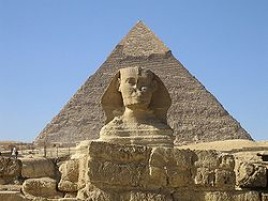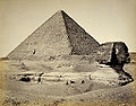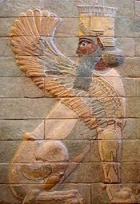The Sphinx,
Sphinx
A sphinx (Ancient Greek: Σφίγξ /sphinx, sometimes Φίξ /Phix) is a mythological creature that is depicted as a recumbent feline with a human head. It has its origins in sculpted figures of lionesses with female human heads (unless the pharaoh was depicted as the son of the deity) of Old KingdomEgypt in association with their solar deities, Bast or Sekhmet. The ancient Greeks adapted this image and applied their own name for a male monster, the "strangler", an archaic figure of Greek mythology. Similar creatures of either gender appear throughout South and South-East Asia. In European decorative art, the sphinx enjoyed a major revival during the Renaissance. Later, the sphinx image, something very similar to the original Ancient Egyptian concept, was exported into many other cultures, albeit often interpreted quite differently due to translations of descriptions of the originals and the evolution of the concept in relation to other cultural traditions.
Generally the role of sphinxes is associated with architectural structures such as royal tombs or religious temples. The oldest known sphinx was found in Gobekli Tepe, Turkey and was dated to 9,500 B.C. Perhaps the first sphinx in Egypt was one depicting Queen Hetepheres II, of the fourth dynasty that lasted from 2723 to 2563 BC. She was one of the longest-lived members of the royal family of that dynasty.
The largest and most famous is the Great Sphinx of Giza, Arabic: أبو الهول, sited at the Giza Plateau on the west bank of the Nile River and facing due east (29°58′31″N 31°08′15″E / 29.97528°N 31.1375°E / 29.97528; 31.1375). It is also from the same dynasty. Although the date of its construction is uncertain, the head of the Great Sphinx now is believed to be that of the pharaoh Khafra.
What names their builders gave to these statues is not known. At the Great Sphinx site, the inscription on a stele erected a thousand years later, by Thutmose IV in 1400 BCE, lists the names of three aspects of the local sun deity of that period, Khepera - Rê - Atum. The inclusion of these figures in tomb and temple complexes quickly became traditional and many pharaohs had their heads carved atop the guardian statues for their tombs to show their close relationship with the powerful solar deity, Sekhmet, a lioness. Other famous Egyptian sphinxes include one bearing the head of the pharaoh Hatshepsut, with her likeness carved in granite, which is now in the Metropolitan Museum of Art in New York, and the alabaster sphinx of Memphis, currently located within the open-air museum at that site. The theme was expanded to form great avenues of guardian sphinxes lining the approaches to tombs and temples as well as serving as details atop the posts of flights of stairs to very grand complexes. Nine hundred with ram heads, representing Amon, were built in Thebes, where his cult was strongest.
Greek traditions
From the Bronze Age, the Hellenes had trade and cultural contacts with Egypt. Before the time that Alexander the Great occupied Egypt, the Greek name, sphinx, was already applied to these statues. The historians and geographers of Greece wrote extensively about Egyptian culture. Heredotus called the ram-headed sphinxes, criosphinxes, and the bird-headed ones, hierocosphinxes.
The word sphinx comes from the Greek Σφίγξ, apparently from the verb σφίγγω (sphíngō), meaning "to strangle". This name may be derived from the fact that the hunters for a pride of lions are the lionesses, and kill their prey by strangulation, biting the throat of prey and holding them down until they die. The word sphincter derives from the same root. However, the historian Susan Wise Bauer suggests that the word "sphinx" was instead, a Greek corruption of the Egyptian name "shesepankh," which meant "living image," and referred rather to the statue of the sphinx, which was carved out of "living rock" (rock that was present at the construction site, not harvested and brought from another location), than to the beast itself.
There was a single sphinx in Greek mythology, a unique demon of destruction and bad luck. According to Hesiod, she was a daughter of Echidna and Orthrus; according to others, she was a daughter of Echidna and Typhon. All of these are chthonic figures from the earliest of Greek myths, before the Olympians ruled the Greek pantheon. Pierre Grimal's The Penguin Dictionary of Classical Mythology states that Sphinx's proper name was Phix (Φίξ), though it does not identify a source for this information. The Sphinx, though, is called by this name (Phix (Φίξ)) by Hesiod in line 326 of the Theogony.
In Greek mythology, a sphinx is represented as a monster with a head of a woman, the body of a lioness, the wings of an eagle, and a serpent headed tail.
The sphinx was the emblem of the ancient city-state of Chios, and appeared on seals and the obverse side of coins from the sixth century BC until the third century AD.
Athena appears in the middle of the upper-half of the middle of a sarcophagus found in the middle pyramid of Giza, with two sphinxes at her side.
The Riddle of the Sphinx
The Sphinx is said to have guarded the entrance to the Greek city of Thebes, and to have asked a riddle of travelers to allow them passage. The exact riddle asked by the Sphinx was not specified by early tellers of the stories, and was not standardized as the one given below until late in Greek history.
It was said in late lore that Hera or Ares sent the Sphinx from her Ethiopian homeland (the Greeks always remembered the foreign origin of the Sphinx) to Thebes in Greece where she asks all passersby the most famous riddle in history: "Which creature in the morning goes on four legs, at mid-day on two, and in the evening upon three, and the more legs it has, the weaker it be?" She strangled and devoured anyone unable to answer. Oedipus solved the riddle by answering: Man—who crawls on all fours as a baby, then walks on two feet as an adult, and then walks with a cane in old age. By some accounts (but much more rarely), there was a second riddle: "There are two sisters: one gives birth to the other and she, in turn, gives birth to the first." The answer is "day and night" (both words are feminine in Greek).
Bested at last, the tale continues, the Sphinx then threw herself from her high rock and died. An alternative version tells that she devoured herself. Thus Oedipus can be recognized as a "liminal" or threshold figure, helping affect the transition between the old religious practices, represented by the death of the Sphinx, and the rise of the new, Olympian gods.
In Jean Cocteau's retelling of the Oedipus legend, The Infernal Machine, the Sphinx tells Oedipus the answer to the riddle, to kill herself so that she did not have to kill anymore, and also to make him love her. He leaves without ever thanking her for giving him the answer to the riddle. The scene ends when the Sphinx and Anubis, who is there to kill the victims who cannot answer the riddle, ascend back to the heavens.
A sphinx (Ancient Greek: Σφίγξ /sphinx, sometimes Φίξ /Phix) is a mythological creature that is depicted as a recumbent feline with a human head. It has its origins in sculpted figures of lionesses with female human heads (unless the pharaoh was depicted as the son of the deity) of Old KingdomEgypt in association with their solar deities, Bast or Sekhmet. The ancient Greeks adapted this image and applied their own name for a male monster, the "strangler", an archaic figure of Greek mythology. Similar creatures of either gender appear throughout South and South-East Asia. In European decorative art, the sphinx enjoyed a major revival during the Renaissance. Later, the sphinx image, something very similar to the original Ancient Egyptian concept, was exported into many other cultures, albeit often interpreted quite differently due to translations of descriptions of the originals and the evolution of the concept in relation to other cultural traditions.
Generally the role of sphinxes is associated with architectural structures such as royal tombs or religious temples. The oldest known sphinx was found in Gobekli Tepe, Turkey and was dated to 9,500 B.C. Perhaps the first sphinx in Egypt was one depicting Queen Hetepheres II, of the fourth dynasty that lasted from 2723 to 2563 BC. She was one of the longest-lived members of the royal family of that dynasty.
The largest and most famous is the Great Sphinx of Giza, Arabic: أبو الهول, sited at the Giza Plateau on the west bank of the Nile River and facing due east (29°58′31″N 31°08′15″E / 29.97528°N 31.1375°E / 29.97528; 31.1375). It is also from the same dynasty. Although the date of its construction is uncertain, the head of the Great Sphinx now is believed to be that of the pharaoh Khafra.
What names their builders gave to these statues is not known. At the Great Sphinx site, the inscription on a stele erected a thousand years later, by Thutmose IV in 1400 BCE, lists the names of three aspects of the local sun deity of that period, Khepera - Rê - Atum. The inclusion of these figures in tomb and temple complexes quickly became traditional and many pharaohs had their heads carved atop the guardian statues for their tombs to show their close relationship with the powerful solar deity, Sekhmet, a lioness. Other famous Egyptian sphinxes include one bearing the head of the pharaoh Hatshepsut, with her likeness carved in granite, which is now in the Metropolitan Museum of Art in New York, and the alabaster sphinx of Memphis, currently located within the open-air museum at that site. The theme was expanded to form great avenues of guardian sphinxes lining the approaches to tombs and temples as well as serving as details atop the posts of flights of stairs to very grand complexes. Nine hundred with ram heads, representing Amon, were built in Thebes, where his cult was strongest.
Greek traditions
From the Bronze Age, the Hellenes had trade and cultural contacts with Egypt. Before the time that Alexander the Great occupied Egypt, the Greek name, sphinx, was already applied to these statues. The historians and geographers of Greece wrote extensively about Egyptian culture. Heredotus called the ram-headed sphinxes, criosphinxes, and the bird-headed ones, hierocosphinxes.
The word sphinx comes from the Greek Σφίγξ, apparently from the verb σφίγγω (sphíngō), meaning "to strangle". This name may be derived from the fact that the hunters for a pride of lions are the lionesses, and kill their prey by strangulation, biting the throat of prey and holding them down until they die. The word sphincter derives from the same root. However, the historian Susan Wise Bauer suggests that the word "sphinx" was instead, a Greek corruption of the Egyptian name "shesepankh," which meant "living image," and referred rather to the statue of the sphinx, which was carved out of "living rock" (rock that was present at the construction site, not harvested and brought from another location), than to the beast itself.
There was a single sphinx in Greek mythology, a unique demon of destruction and bad luck. According to Hesiod, she was a daughter of Echidna and Orthrus; according to others, she was a daughter of Echidna and Typhon. All of these are chthonic figures from the earliest of Greek myths, before the Olympians ruled the Greek pantheon. Pierre Grimal's The Penguin Dictionary of Classical Mythology states that Sphinx's proper name was Phix (Φίξ), though it does not identify a source for this information. The Sphinx, though, is called by this name (Phix (Φίξ)) by Hesiod in line 326 of the Theogony.
In Greek mythology, a sphinx is represented as a monster with a head of a woman, the body of a lioness, the wings of an eagle, and a serpent headed tail.
The sphinx was the emblem of the ancient city-state of Chios, and appeared on seals and the obverse side of coins from the sixth century BC until the third century AD.
Athena appears in the middle of the upper-half of the middle of a sarcophagus found in the middle pyramid of Giza, with two sphinxes at her side.
The Riddle of the Sphinx
The Sphinx is said to have guarded the entrance to the Greek city of Thebes, and to have asked a riddle of travelers to allow them passage. The exact riddle asked by the Sphinx was not specified by early tellers of the stories, and was not standardized as the one given below until late in Greek history.
It was said in late lore that Hera or Ares sent the Sphinx from her Ethiopian homeland (the Greeks always remembered the foreign origin of the Sphinx) to Thebes in Greece where she asks all passersby the most famous riddle in history: "Which creature in the morning goes on four legs, at mid-day on two, and in the evening upon three, and the more legs it has, the weaker it be?" She strangled and devoured anyone unable to answer. Oedipus solved the riddle by answering: Man—who crawls on all fours as a baby, then walks on two feet as an adult, and then walks with a cane in old age. By some accounts (but much more rarely), there was a second riddle: "There are two sisters: one gives birth to the other and she, in turn, gives birth to the first." The answer is "day and night" (both words are feminine in Greek).
Bested at last, the tale continues, the Sphinx then threw herself from her high rock and died. An alternative version tells that she devoured herself. Thus Oedipus can be recognized as a "liminal" or threshold figure, helping affect the transition between the old religious practices, represented by the death of the Sphinx, and the rise of the new, Olympian gods.
In Jean Cocteau's retelling of the Oedipus legend, The Infernal Machine, the Sphinx tells Oedipus the answer to the riddle, to kill herself so that she did not have to kill anymore, and also to make him love her. He leaves without ever thanking her for giving him the answer to the riddle. The scene ends when the Sphinx and Anubis, who is there to kill the victims who cannot answer the riddle, ascend back to the heavens.



